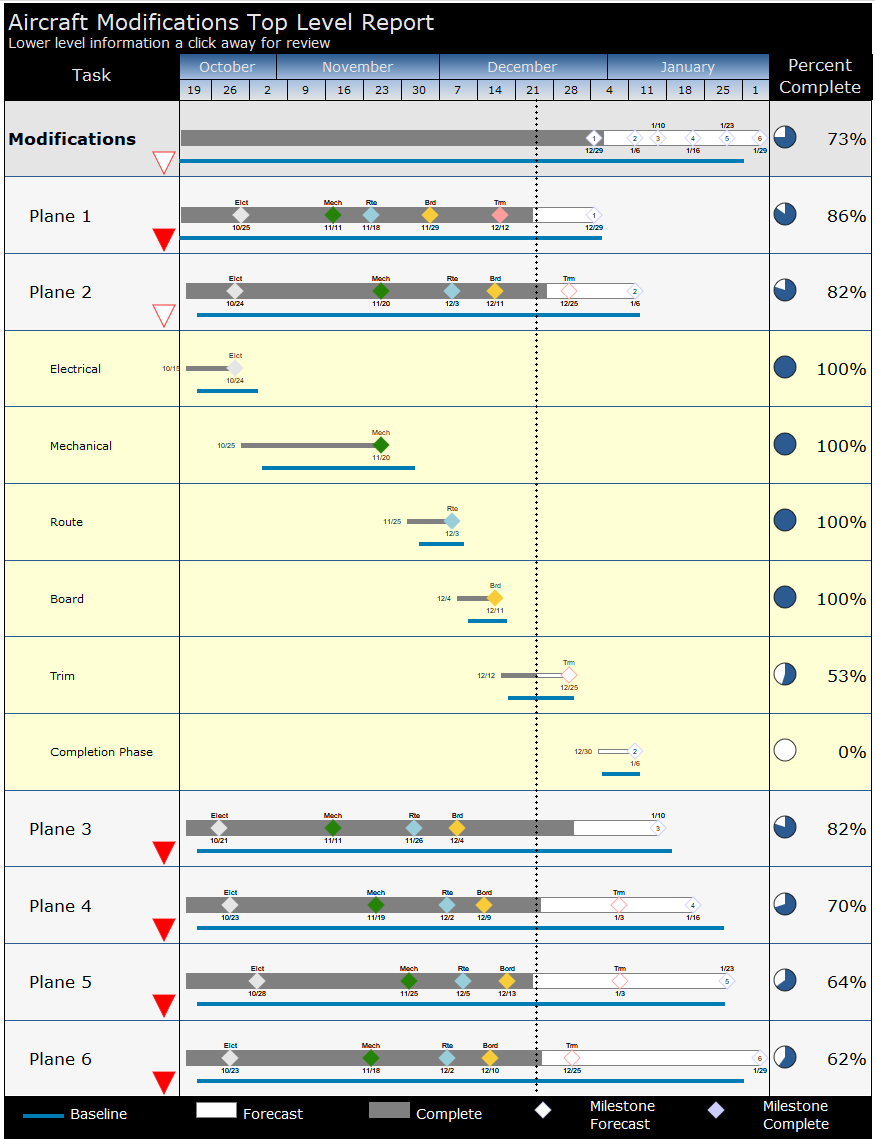ABOUT GANTT CHARTS
A Gantt chart is a graphical representation of the duration of tasks against the progression of time. Gantt charts are useful tools for planning and scheduling projects.
A Gantt chart is helpful when monitoring a project’s progress. A Gantt chart is a type of bar chart that illustrates a project schedule. Gantt charts illustrate the start and finish dates of the terminal elements and summary elements of a project.
Terminal elements and summary elements comprise the work breakdown structure of the project. Some Gantt charts also show the dependency relationships between activities.
Gantt charts can be used to show current schedule status using percent-complete shadings and a vertical “Today” line.
Learn about Gantt Chart software.
Planning and Scheduling
Use a Gantt chart to plan how long a project should take. A Gantt chart lays out the order in which the tasks need to be carried out.
Early Gantt charts did not show dependencies between tasks but modern Gantt chart software provides this capability.
Henry Laurence Gantt, an American mechanical engineer, is credited with the invention of the Gantt chart.
Monitoring a Project
A Gantt chart lets you see immediately what should have been achieved at any point in time.
A Gantt chart lets you see how remedial action may bring the project back on course. Most Gantt charts include “milestones” which are not part of a traditional Gantt Chart.
However, for representing deadlines and other significant events, it is very useful to include this feature on a Gantt chart.
Evolution of the Gantt Chart
Here’s a simple example that might have been used around the time Gantt charts were invented (if computers had also been available to make the charts look this precise:)
Early Gantt chart users showed progress using a simple “fill in the bar” method to show how much of the project was complete:
They also might have shown the planned bar along side the progress bar like this:
Another type of chart which was used along with the Gantt chart was the basic “Milestone chart”. This type of chart shows only important project events or milestones.
Modern forms of last century’s Gantt chart are shown below.
Gantt Chart Example: Software Plan – Draft Under Review
Gantt Charts are only final once the project is complete. Up until that point they are likely to undergo many revisions as tasks slip and have to be rescheduled. Luckily, in today’s world, these charts don’t have to be manually redrawn (with pen and paper as they did in the early 1900s). Many modern software packages make it easy to just change a date and voila! get a new chart.
This Gantt Chart example shows the various phases of a software project with Team Meeting milestones for each phase.
Top Level Schedule
Here’s an example of a typical presentation Gantt Chart showing the top level tasks for a project.
Gantt Chart Example: Aircraft Modifications Top Level Report
When working with a multi-page Gantt chart, it’s helpful to be able to hide the detail and only show it when needed. Project management software that lets you roll-up (hide) tasks or expand (un-hide) tasks is great for this purpose. In the example below, modifications are shown for several planes. Plane 1 is rolled up and Plane 2 is expanded. It’s easy to see the key milestones for each plan on its summary display.
Gantt Chart Example: Dashboard Chart
Right, a dashboard is something you see on a car, right? Well, just as a car’s dashboard shows you all the key indicators, a project management dashboard shows you key indicators for your project. It’s easy to see at-a-glance on this Gantt chart how each project is doing. Just look at the Stoplight column!
Gantt Chart Example: Shuttle Mission Schedule
Here’s a flashback to last century! NASA used Milestones software to produce Mission Schedules for the Space Shuttle launches. They love the ability to see the key milestones for each project all on one piece of paper.
Gantt Chart Example: Project Funding Dashboard
This is another great example of a Gantt Chart used to show Project Funding. It shows each major task for several construction projects. Earned Value is shown below the Gantt Chart and a Stoplight column shows if funds for the task are depleted.












